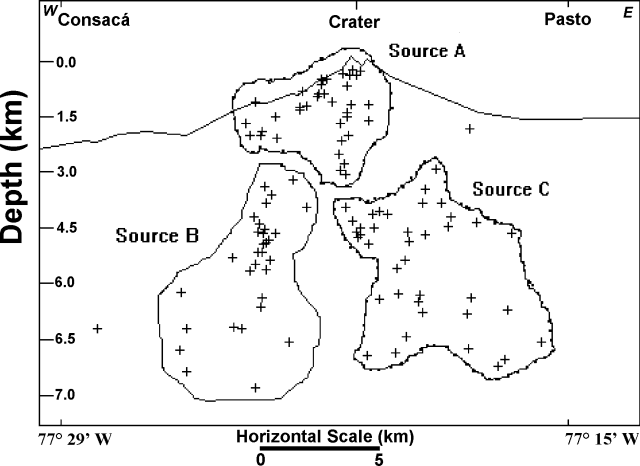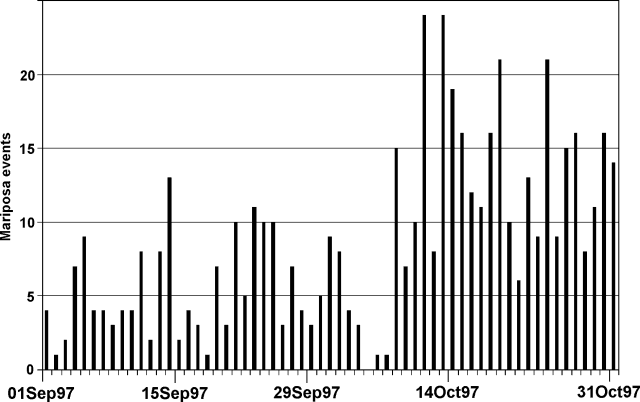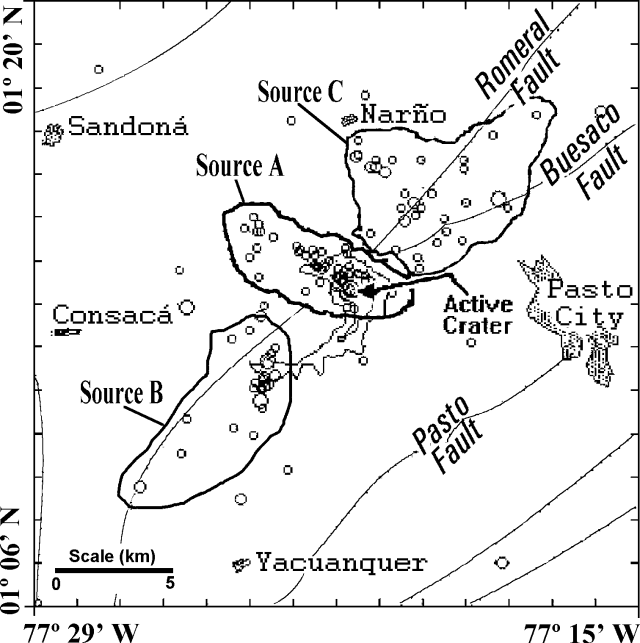Report on Galeras (Colombia) — December 1997
Bulletin of the Global Volcanism Network, vol. 22, no. 12 (December 1997)
Managing Editor: Richard Wunderman.
Galeras (Colombia) Continuing low seismic activity during September-October 1997
Please cite this report as:
Global Volcanism Program, 1997. Report on Galeras (Colombia) (Wunderman, R., ed.). Bulletin of the Global Volcanism Network, 22:12. Smithsonian Institution. https://doi.org/10.5479/si.GVP.BGVN199712-351080
Galeras
Colombia
1.22°N, 77.37°W; summit elev. 4276 m
All times are local (unless otherwise noted)
Visual and instrumental observations during September-October 1997 indicated continuing low-level seismicity. Some volcano-tectonic (VT) earthquakes registered above the background long-period (LP) seismicity.
Important VT events occurred in three different zones around the active cone as indicated in figure 83; "Source A" refers to the cone's immediate area, "Source B," to the SW of the caldera rim, and "Source C," to an area N and E of the crater that has been seismically active since 1993. During September-October, 62 VT events were recorded. On average, 1-2 events occurred per day; the maximum daily count was 11 earthquakes. Most events occurred <10 km below the summit; most shallow events were centered in the Source A area at depths <4.5 km (figure 84). On 12 October, a substantial concentration of activity in the Source A area included 10 VT events in ~ 30 minutes; the most energetic event was M 2.7, located 4 km below the crater. Source B was particularly active in the last week of October when there were several VT events of M 2.0-2.5 at depths generally from 3-10 km. Source C was the most active area. On 23 September, a M 2.2 event centered in Source C (5 km NNE of the crater) at a depth of 8 km was felt in Pasto.
 |
Figure 84. Hypocenters of VT events recorded during September-October 1997. The zones of activity are outlined. Courtesy of OVP-INGEOMINAS. |
Concurrent with these events, LP seismicity was observed sporadically at very low levels. Mariposa ("butterfly") events characterized as a hybrid between a VT and LP, generally showed low levels of energy and shallow depths below the active crater. Frequencies were similar to previous months. From the second week of October the daily number of Mariposa events increased (figure 85). This change was coincident with the increase in Source-B activity during the last week of October.
 |
Figure 85. Daily occurrence of Mariposa events detected at Galeras volcano, September-October 1997. Courtesy of OVP-INGEOMINAS. |
Degassing and morphological change continued to be concentrated mainly toward the W side of the active cone; observations made in the last few months revealed no major changes. The electronic tiltmeter station at Peladitos (1.6 km E of the active cone) showed a general stability. However, after 9 October it recorded a slight change in radial and tangential components; this was also observed in the temperature channel. The changes could be related to the seismic activity (VT and Mariposa events) recorded during that period.
Geological Summary. Galeras, a stratovolcano with a large breached caldera located immediately west of the city of Pasto, is one of Colombia's most frequently active volcanoes. The dominantly andesitic complex has been active for more than 1 million years, and two major caldera collapse eruptions took place during the late Pleistocene. Long-term extensive hydrothermal alteration has contributed to large-scale edifice collapse on at least three occasions, producing debris avalanches that swept to the west and left a large open caldera inside which the modern cone has been constructed. Major explosive eruptions since the mid-Holocene have produced widespread tephra deposits and pyroclastic flows that swept all but the southern flanks. A central cone slightly lower than the caldera rim has been the site of numerous small-to-moderate eruptions since the time of the Spanish conquistadors.
Information Contacts: Pablo Chamorro and Diego Gomez Martinez, Observatorio Vulcanológico y Sismologico de Pasto (OVP), INGEOMINAS, Carrera 31, No. 18-07 Parque Infantil, PO Box 1795, Pasto, Colombia (URL: https://www2.sgc.gov.co/volcanes/index.html).


